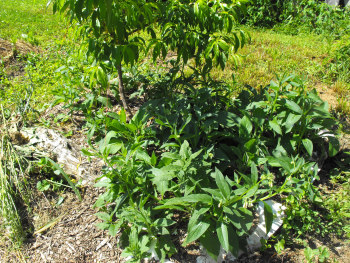
What is a forest garden?
 Robert
Hart was a pioneer of Forest Gardening, but Dave Jacke and Eric
Toensmeier are its eastern U.S. advocates. Together, they've
created my favorite books of the year --- Edible Forest Gardens, volume
1 and volume
2, which give you the theory behind forest gardening and all of the
specifics you need to create your own.
Robert
Hart was a pioneer of Forest Gardening, but Dave Jacke and Eric
Toensmeier are its eastern U.S. advocates. Together, they've
created my favorite books of the year --- Edible Forest Gardens, volume
1 and volume
2, which give you the theory behind forest gardening and all of the
specifics you need to create your own.
Jacke and Toensmeier define an edible forest garden as a "perennial
polyculture of multipurpose plants." In essence, they use an
understanding of ecology to mimic the temperate forests you can find in
wild places around you. But instead of letting nature take its
course, they fill each niche of their forest with species that provide
food for humans, nectar for beneficial insects, or enrich the soil.
 Each
plant in the polyculture has a different growth form and different
needs, so they don't actively compete for the most important
resources. For example, consider growing comfrey as a thick
groundcover under fruit trees. Most
of our fruit trees have shallow roots that feed primarily in the top
few inches of the soil,
while comfrey grows taproots that delve deep into the subsoil in search
of water and nutrients. Since the roots of the two species are in
different parts of the soil, the comfrey and fruit tree won't compete
much for nutrients, and the comfrey will actually help feed the tree
when the comfrey's
high quality leaves
die back and rot into the surface of the soil. Meanwhile, the
comfrey crowds out grass and other shallow-rooted weeds that would
otherwise compete with the fruit tree.
Each
plant in the polyculture has a different growth form and different
needs, so they don't actively compete for the most important
resources. For example, consider growing comfrey as a thick
groundcover under fruit trees. Most
of our fruit trees have shallow roots that feed primarily in the top
few inches of the soil,
while comfrey grows taproots that delve deep into the subsoil in search
of water and nutrients. Since the roots of the two species are in
different parts of the soil, the comfrey and fruit tree won't compete
much for nutrients, and the comfrey will actually help feed the tree
when the comfrey's
high quality leaves
die back and rot into the surface of the soil. Meanwhile, the
comfrey crowds out grass and other shallow-rooted weeds that would
otherwise compete with the fruit tree.
Forest gardeners talk about creating guilds --- groups of useful
species that grow together without undue competition. When
creating guilds for your forest garden, you need to understand each
species' growth form, size, root pattern, need for light, water and
nutrients, and seasonal growth pattern. Then mix and match plants
that seem to fill different niches, paying special attention to the
most limiting resource (be that light, nutrients, or water, depending
on your environment.) Check out volume two of Edible Forest Gardens for
very helpful lists, or just browse through the guilds I'm
starting to build in my forest garden.
| This post is part of our History of Permaculture lunchtime series.
Read all of the entries: |
Want more in-depth information? Browse through our books.
Or explore more posts by date or by subject.
About us: Anna Hess and Mark Hamilton spent over a decade living self-sufficiently in the mountains of Virginia before moving north to start over from scratch in the foothills of Ohio. They've experimented with permaculture, no-till gardening, trailersteading, home-based microbusinesses and much more, writing about their adventures in both blogs and books.
Want to be notified when new comments are posted on this page? Click on the RSS button after you add a comment to subscribe to the comment feed, or simply check the box beside "email replies to me" while writing your comment.
